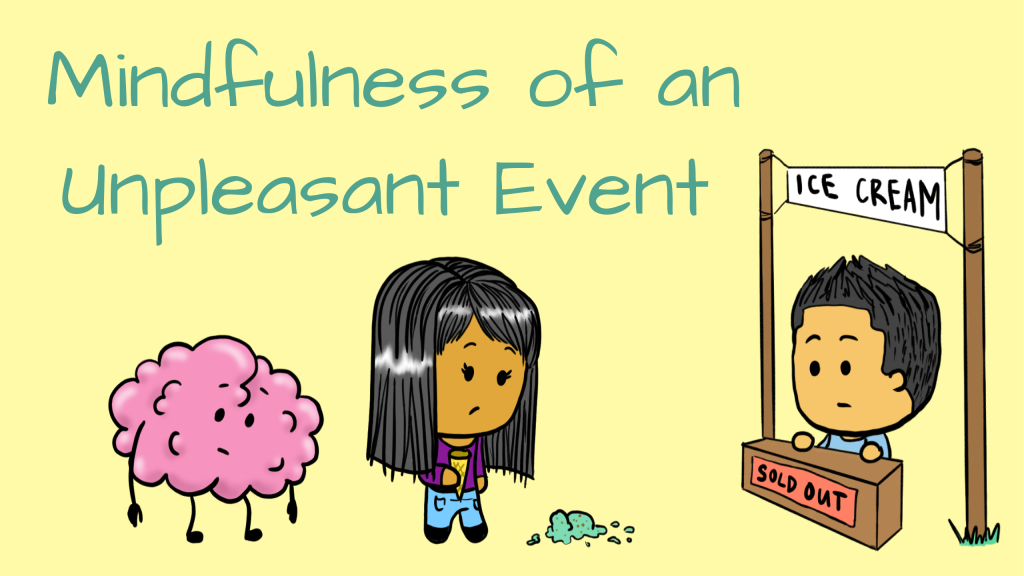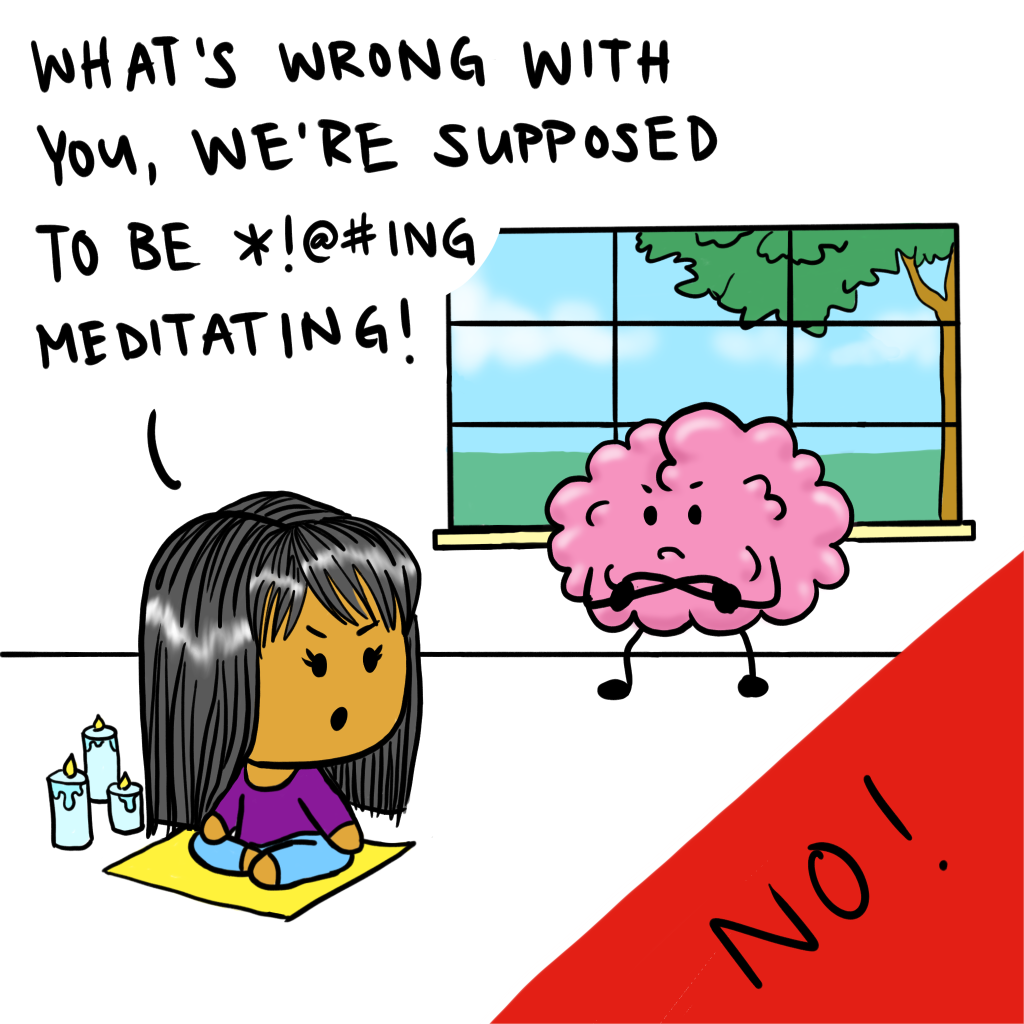I created a new saying with my husband to communicate when I’m so busy my head’s about to explode. It happened by accident. He came home from work on a seemingly normal day and asked me a simple question, not knowing that I had spent the whole day putting out fires with the sweat and tears of my very soul. I don’t even remember what he asked of me, but it was enough to make my head actually explode, and I couldn’t find the words to explain myself, except to blurt out, “I’M TO THE BRIMMMM!!!!”
Even though it was a bit of a word vomit, it somehow sounds more accurate than, “I’m too busy to do anything else right now.” Sometimes, saying the word ‘busy’ is a massive understatement.
This makes the idea of self care a bit tricky. I can barely keep track of whether I’m showering at an appropriate frequency for an adult. How do you expect me to, like, go to a yoga class??

People are starting to pay more attention to mindfulness as a way to take care of their mental and emotional wellbeing. The problem is, when I bring up mindfulness in my therapy groups, the first, and sometimes only thing people talk about is meditation.
Why is this a problem? Meditation is a great way to practice mindfulness. But our tendency to equate meditation with mindfulness is limiting our potential to harness its power.
One of my favorite things about mindfulness is how accessible it is. There are endless options for mindful practices that don’t require you to set aside extended periods of quiet time. All you need is the here-and-now, and that’s always available to you. For free!
So I compiled here a list of 10 mindfulness exercises you can do even on the busiest of days.
But before you start, a couple tips and disclaimers:
On getting distracted

Like with meditation, these activities will exercise your concentration on something specific. It’s not what your brain’s used to. So, when (not if) your mind gets distracted, simply acknowledge it to yourself (I’m noticing I’m distracted by thoughts about wanting to eat a bowl of cereal..), then gently redirect your attention. Be kind to yourself!

You’ll likely get distracted many, many times; sometimes several times in quick succession. This is normal. In fact, there’s really no point in practicing mindfulness if you don’t get distracted. Learning to catch your mind wandering without judging yourself is all part of the game. (In fact, if/when you judge yourself for not being able to focus 100%, make it part of the exercise: I’m noticing thoughts of judgement toward myself for not being able to focus 100%.)
For trauma survivors
Take caution when doing any kind of meditation or mindfulness exercise if you are working through serious past trauma. Disconnecting from your present experience can actually be an adaptive way you’ve come to protect yourself during the healing process. It may take time to build up to doing exercises in which you pay very close attention to your inner world. Trauma has a way of ‘living in the body’, so mindful attention to things like your breath and body sensations may quickly lead to overwhelm, and could be counterproductive to your progress.

Starting out with exercises that last just a few minutes rather than 10+ minute long meditations is helpful. Some find they’re more tolerant of mindful exercises that focus on external things (what you see around you) rather than internal things (breathing, thoughts/feelings, body sensations). If you’re still unsure about how to best start mindful practices, you can consult your personal therapist.
10 Everyday Mindfulness Exercises
These 10 simple mindfulness exercises have been adapted from techniques in Mindfulness Based Cognitive Therapy (MBCT), developed by Zindel Segal, Mark Williams, and John Teasdale:
Mindful Eating
Any kind of food will do. This mindful activity draws attention to the five senses as you eat. If this is your first time doing it, try it on your own and take your time. Later, you can do this around other people, and at your own speed; it doesn’t have to ‘look weird’ and you don’t have to eat super slow. It’s your quality of attention that matters. You can choose to go through all five senses, or you can just pick one or two. As Bob Ross would say, It’s your world.
Mindful Walking
This is most fun to do barefoot and/or out in nature, but those are not required for a mindful walk. It could just be a mindful walk down the hallway of your office. The five senses are your focal points again, as well as your movement and body sensations.
Mindful Stretching
This can be done while sitting, say, when you’re in front of a computer or after a meal. It’s another ‘normal-looking’ thing that you can do that won’t interrupt your routine. There’s more emphasis on mindfulness of body sensations and movement.
Mindful Breathing
This can be done anytime you happen to be breathing. It doesn’t even have to be a calm, baseline steady breathe; you can be exercising while you do this. Or not. Whatevs. Your attention is again guided toward movement and body sensations.
Mindfulness of a routine activity
This is like a grab-bag of designated mindful time! Choose any activity you do daily, or almost daily, such as brushing your teeth, doing dishes, or feeding your pet. Then, choose some or all of the following to focus on, one at a time: 5 senses, movement, body sensations, thoughts, and/or emotions. This audio is for a face washing session to give you an idea of what this can look like. The main point of this is to make mindfulness a daily practice.
Body Scan
Throughout the body scan, you’ll be paying attention to different body parts and their sensations, such as tension. FYI, you don’t have to make this a relaxation activity. The only goal for mindful practice is awareness. So, you can be exercising/moving/doing anything while you do this. OR you can sit, and relax muscles when you feel tension. Up to you.
Mindfulness of thoughts
Here, you’ll acknowledge your free flowing thoughts and feelings. Your greatest challenge will be tracking them without judging them to be good or bad (I’m noticing feelings of frustration with my roommate– Aaah I shouldn’t feel frustrated!). Okay, spoiler: You’ll be judging your thoughts/feelings left and right. So, to deal with that, whenever you judge a thought or feeling, acknowledge it by saying something to yourself like, I’m noticing I’m judging myself for feeling frustrated. It might even get as ‘meta’ as I’m noticing I’m judging myself for judging myself.
Mindfulness of pleasant events
Unlike the typical observe-the-here-and-now technique of the previous exercises, this audio will guide you through recalling memories of a past pleasant event. To paraphrase Marie Kondo, the very mindful author and TV personality from Tidying Up, the more you tap into the details of what it’s like to experience joy, the easier it will be to recognize it when you feel it.
Mindfulness of unpleasant event
I know what you may be thinking. WHY on Earth would I do this to myself?? Two words: Distress tolerance. We’re bound to experience unpleasant things, to varying degrees. We make things worse by trying to stuff and deny our experience (Yeah, I’m gonna stuff my anger about this way down deep), or by resisting the reality we’re confronted with (This can’t be happening! It shouldn’t be happening! Why is this happening??). This exercise won’t make bad things go away, but it will help you practice being able to confidently breathe through unpleasantness without making things worse.
This is guided the same way as it is for a pleasant event, so if you want to try it out, click on the ‘mindfulness of a pleasant event’ video, and imagine something unpleasant instead. Choose something mildly unpleasant to start with, like misplacing your keys or looking at the giant pile of laundry you don’t want to fold (Marie Kondo can help with that BTW).

3 minute breathing space
This brief exercise is meant to build the habit of shifting your attention, checking in, and moving on. It’s one minute of focusing on thoughts, feelings, and sensations, one minute zeroing in on your breathe, and one minute of overall body awareness.

I like this one Kalene….
>
LikeLike
😊 Thank you!
LikeLike
I always learn something new like “distress tolerance” and your drawings are a joyful mindful moment. Is that Fahaad at the ice cream stand.
LikeLike
Thank you! My job uses a lot from Dialectical Behavioral Therapy, so ‘distress tolerance’ and a lot of other good terms come from it. Fahd has made some other appearances in my drawings, but he always complains about how I draw the shape of his bald head 😋
LikeLike